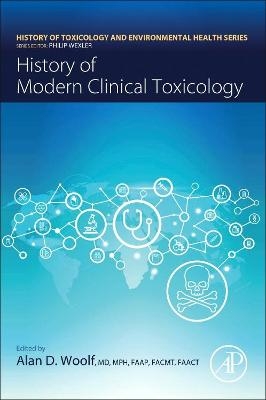
History of Modern Clinical Toxicology
Academic Press Inc (Verlag)
978-0-12-822218-8 (ISBN)
Dr. Alan Woolf has been the Director of the Region 1 New England Pediatric Environmental Health Specialty Unit, a facility that offers consultation to health professionals and the public about clinical topics in environmental toxicology, for more than 20 years. He was also the Medical Director of the Massachusetts/Rhode Island Poison Control Center for 18 years. He is a former president of the American Academy of Clinical Toxicology and the American Association of Poison Control Centers, two of the premier clinical toxicology societies in America. Dr. Woolf is a Professor of Pediatrics, Harvard Medical School (HMS), Director of the Pediatric Environmental Health Center at Boston Children’s Hospital (BCH), and Director of the Fellowship Training Program in Pediatric and Reproductive Environmental Health at BCH. Dr. Woolf and his colleagues research includes topics in clinical toxicology, medical therapies in the management of childhood poisonings, and topics in poisoning epidemiology and prevention.
Section 1. Disasters: Examples of toxic calamities in modern times 1.1 Triortho cresyl phosphate “Ginger Jake disaster—United States, 1930s 1.2 Three methylmercury poisoning disasters 1.3 Community dioxin disaster—Seveso, Italy, 1976 1.4 Arsenic in tube well water—Bangladesh, 1970s–1990s 1.5 Toxic oil syndrome—Spain, 1981 1.6 Eosinophilia-myalgia syndrome—United States, 1989 1.7 Methyl isocyanate—Bhopal, India, 1984 1.8 Zamfara gold mining lead poisoning disaster—Nigeria, Africa, 2010 1.9 Itai-Itai disease—Japan, 1955 1.10 Japan “Yusho poisoning, 1968 and Taiwan “Yucheng poisoning, 1979
Section 2. Notable pharmaceutical poisoning incidents and poisoned people 2.1 Sulfanilamide (diethylene glycol) disaster—United States, 1937 2.2 Gasping syndrome, 1982 2.3 Tylenol cyanide poisoning in United States, 1982 2.4 Thalidomide tragedy, 1950s 2.5 Dimethylmercury death—Professor Wetterhahn, 1996 2.6 Yushchenko (dioxin), 2004 and Markov (ricin), 1978: Two political poisonings
Section 3. Discovery of selected modern antidotes 3.1 N-Acetylcysteine 3.2 Fomepizole 3.3 Methylene blue 3.4 British anti-lewisite (dimercaprol) 3.5 Pralidoxime and oximes 3.6 Naloxone 3.7 Physostigmine 3.8 Cyanide antidotes
Section 4. Clinical toxicology and poison control in the United States 4.1 U.S. Poison Control Centers get organized: 1950s–1960s 4.2 Era of regionalization and standardization: 1970s–1980s 4.3 The information technology revolution: 1990s 4.4 New millennium, new directions: 2000–2020 4.5 Professionalism in US Clinical Toxicology—Training, practice, consultation, and societies
Section 5. Clinical toxicology and poison information in Europe, Scandinavia, and Israel 5.1 United Kingdom and Ireland 5.2 Czech Republic and other Central European and Eastern European countries 5.3 Russia 5.4 Germany 5.5 The Netherlands 5.6 Belgium 5.7 France 5.8 Spain and Portugal 5.9 Italy 5.10 Switzerland 5.11 Scandinavia 5.12 Israel 5.13 Contribution of the World Health Organization to toxicology and poisons centers 5.14 The European Association of Poisons Centres and Clinical Toxicologists (EAPCCT)
Section 6. Clinical toxicology and poison control in Asia and Australia 6.1 Australia 6.2 The Chinese mainland 6.3 Taiwan 6.4 The Philippines 6.5 Vietnam 6.6 Thailand 6.7 South Korea
| Erscheinungsdatum | 21.10.2021 |
|---|---|
| Reihe/Serie | History of Toxicology and Environmental Health |
| Verlagsort | San Diego |
| Sprache | englisch |
| Maße | 152 x 229 mm |
| Gewicht | 1020 g |
| Themenwelt | Studium ► 2. Studienabschnitt (Klinik) ► Pharmakologie / Toxikologie |
| ISBN-10 | 0-12-822218-2 / 0128222182 |
| ISBN-13 | 978-0-12-822218-8 / 9780128222188 |
| Zustand | Neuware |
| Informationen gemäß Produktsicherheitsverordnung (GPSR) | |
| Haben Sie eine Frage zum Produkt? |
aus dem Bereich


